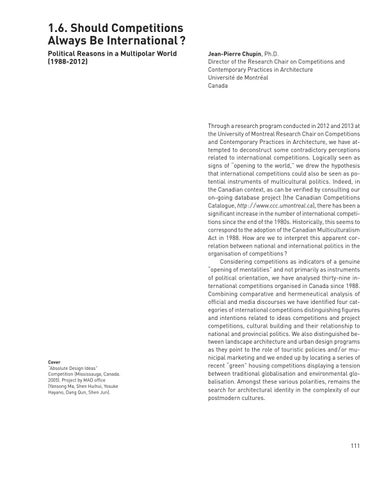1.6. Should Competitions Always Be International ? Political Reasons in a Multipolar World (1988-2012)
Cover “Absolute Design Ideas” Competition (Mississauga, Canada. 2005). Project by MAD office (Yansong Ma, Shen Huihui, Yosuke Hayano, Dang Qun, Shen Jun).
Jean-Pierre Chupin, Ph.D. Director of the Research Chair on Competitions and Contemporary Practices in Architecture Université de Montréal Canada
Through a research program conducted in 2012 and 2013 at the University of Montreal Research Chair on Competitions and Contemporary Practices in Architecture, we have attempted to deconstruct some contradictory perceptions related to international competitions. Logically seen as signs of “opening to the world,” we drew the hypothesis that international competitions could also be seen as potential instruments of multicultural politics. Indeed, in the Canadian context, as can be verified by consulting our on-going database project (the Canadian Competitions Catalogue, http : / / www.ccc.umontreal.ca), there has been a significant increase in the number of international competitions since the end of the 1980s. Historically, this seems to correspond to the adoption of the Canadian Multiculturalism Act in 1988. How are we to interpret this apparent correlation between national and international politics in the organisation of competitions ? Considering competitions as indicators of a genuine “opening of mentalities” and not primarily as instruments of political orientation, we have analysed thirty-nine international competitions organised in Canada since 1988. Combining comparative and hermeneutical analysis of official and media discourses we have identified four categories of international competitions distinguishing figures and intentions related to ideas competitions and project competitions, cultural building and their relationship to national and provincial politics. We also distinguished between landscape architecture and urban design programs as they point to the role of touristic policies and / or municipal marketing and we ended up by locating a series of recent “green” housing competitions displaying a tension between traditional globalisation and environmental globalisation. Amongst these various polarities, remains the search for architectural identity in the complexity of our postmodern cultures.
111
